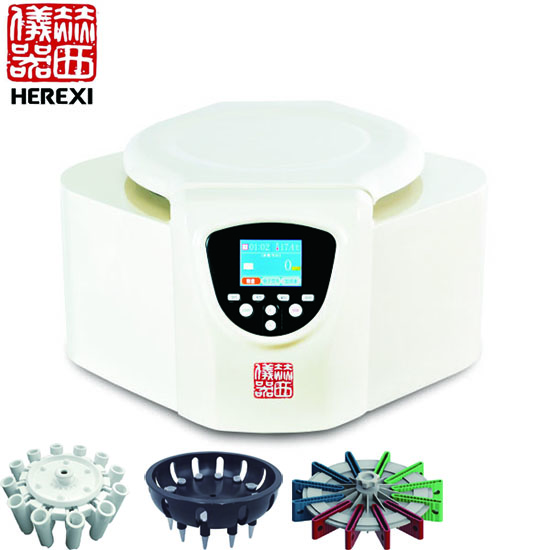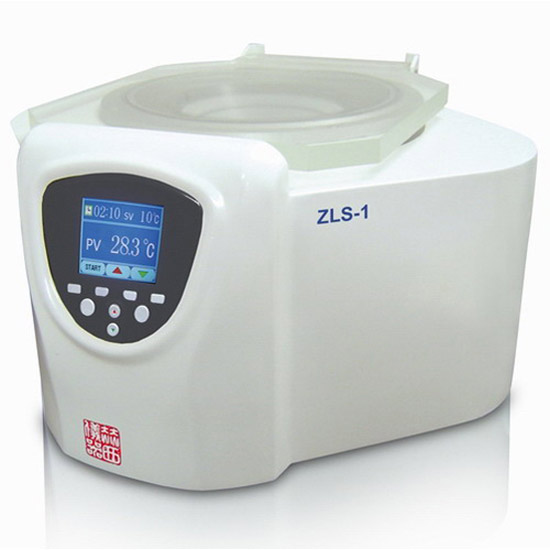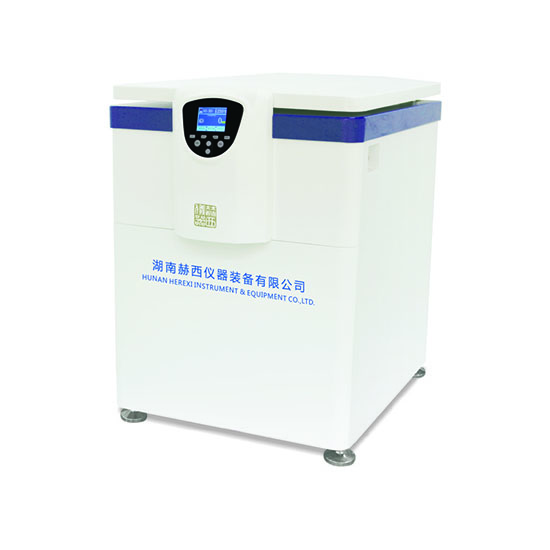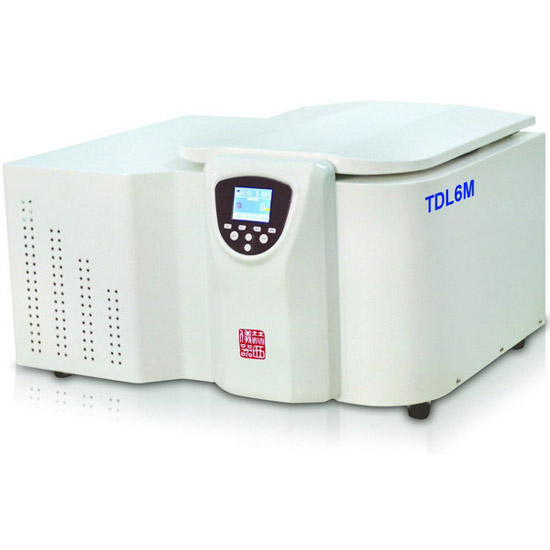How to correctly select medical laboratory centrifuges
Part of the article:Release time:2021/4/30visitor sessions:4129
Laboratory infrastructure is essential equipment of scientific research and clinical medicine, but many LABS often pay attention to the clinical inspection and ignore basic analytical equipment, and the basis of the centrifuge is the most commonly used equipment, so the lab when selecting a centrifuge, target according to the experiment to choose the appropriate centrifuge and suitable for the use of the site and temperature, such as hospital laboratory, The selection of centrifuge needs to be considered in the process, the use of centrifuge is, such as the separation of plasma, serum, precipitation of organic cells, PCR laboratory, in the process of use whether the need for temperature control (freezing function) and other functions! Once the selection error, it is likely to affect the experimental results, resulting in the difference of the whole experimental data. So when choosing a centrifuge, we must first understand the centrifuge, please understand the centrifuge with small Herr below!
First, the working principle of centrifuge
Centrifuge is the use of centrifugal force, separation of liquid and solid particles or liquid and liquid mixture of each component of the machinery. The centrifuge is mainly used to separate the solid particles from the liquid in the suspension, or to separate two kinds of liquid in the emulsion with different densities and insoluble each other (for example, to separate the cream from the milk); It can also be used to remove liquid from wet solids, such as dry and wet clothes in a washing machine; Special overspeed tube separator can also separate gas mixtures of different densities; Some sedimentation centrifuges can also classify solid particles according to their density or particle size because of the different settling speed of solid particles in liquid.
Two, how to calculate the centrifugal force
Centrifugal force is one of the most important parameters to measure a centrifuge, and it is also one of the difference specifications of the centrifuge level. The maximum centrifugal force of the centrifuge will be given when the centrifuge leaves the factory. And the rotor rotation radius is different, at the same speed, its centrifugal force is different, so the centrifugal force is usually calculated, please refer to the following formula:
Centrifugal force calculation formula:

Three, the classification of centrifuges
There are many classification of centrifuges. According to different use scenarios and the common classification of centrifuges suitable for separation test targets are: low speed centrifuge, high speed centrifuge, ultra-high speed centrifuge, normal temperature centrifuge, frozen centrifuge, vacuum centrifuge, continuous flow centrifuge, sedimentation centrifuge, filter centrifuge. Different sizes of centrifuges, the maximum capacity is also different, mainly divided into trace, small, large capacity and so on! In order to meet the experimental needs, the centrifuge can also be divided into fine centrifuge and common centrifuge. The fine centrifuge has comprehensive functions, accurate speed and capacity, and is suitable for some tests with high demand on the centrifuge, such as PCR test, blood component separation (mostly used in blood stations), etc.
The following is a detailed introduction to the selection of fine centrifuge should be careful:
1) speed: Centrifuges are divided into low speed centrifuges (<10000 RPM/min), high speed centrifuges (10000 RPM/min-30000rpm/min) and ultra-high speed centrifuges (>30000 RPM/min) according to the different maximum speed. The maximum speed of each centrifuge refers to the speed under no-load condition. However, the maximum speed will vary according to different rotor types and sample mass. For example, the maximum speed of a centrifuge is 16000rpm/min, indicating that the rotor rotates 16000rpm/min at no-load time. With the samples, the speed will definitely be less than 16000rpm/min. Different rotor, the maximum speed is also different, a centrifuge can be equipped with multiple rotors, horizontal rotor maximum can only reach 5000 RPM/min, the need for speed up to 5000rpm/min or more of the optional Angle rotor, so in the selection of speed should be careful, the selected centrifuge maximum speed is higher than the policy speed.
(2) temperature: some samples (such as proteins, cells, etc.) will be damaged in high temperature environment, which is necessary to choose the frozen centrifuge, frozen centrifuge has temperature compensation function. When the centrifuge is operating at high speed, the heat generated by the centrifuge and the refrigeration system of the centrifuge are balanced within the range of setting temperature ±2 degrees, and the specific amount can be reached is also related to the rotor.
Capacity: how many sample tubes are required for centrifugation each time? How much capacity is required for each sample tube? These conditions determine the size of the rotor to be selected.
(4) The rotor: the centrifuge rotor is mainly divided into two kinds, horizontal rotor: when the operation of the blue hanging in the horizontal state, and the shaft at right angles, the sample will be piled on the bottom of the centrifugal tube: Angle rotor: centrifugal container and shaft into a fixed Angle, the sample will be piled on the bottom of the centrifugal tube and near the bottom of the side wall.
There are also some special tests or special samples requiring special rotors such as: large capacity basket (mostly used in blood stations), ELISA plate rotor, slide rotor, PCR rotor, tube stand rotor and capillary rotor, etc. The rotor has a fixed specification, which is combined with the capacity of the centrifuge, such as the Angle rotor of 36×5 mL. It not only chooses the type of rotor but also the capacity of the centrifuge, so the selection of the rotor is very important.
(5) Control system: advanced centrifuges use microcomputer control system, these control system can not only ensure the safe operation of the centrifuge but also take the initiative to end the task. Nowadays, many centrifuges have good humanized control system. For example: rotor identification function, safety lock function, shortcomings prompt function, speed up and deceleration curve and so on. In addition to the above points to take care of some details and necessary accessories. The first part of the centrifuge is the motor, which is divided into motors with carbon brushes and motors without carbon brushes. The former has fallen behind, but most of today's centrifuges are motors without carbon brushes, which avoid carbon powder pollution and carbon powder conducting damage to the circuit. Some motors have natural braking function. Refrigerated centrifuges are also different in refrigeration, and today's environmentally friendly technology is, of course, fluorine-free refrigeration. In addition to thinking about the noise problem, try to choose a centrifuge with less noise, so that you can adhere to a comfortable test environment. In terms of accessories, we should also be careful. Some tests should use special centrifugal tubes (for centrifugal toxic samples or samples requiring ultra-high speed centrifugation). It is necessary to equip the centrifugal tubes with corresponding sleeve to be safer. There are also some special sample containers (irregular sample bottles, blood bags, etc.), these details and accessories should be carefully considered when selecting the centrifuge, otherwise normal operations can not be carried out.
Four, the difference between domestic and imported centrifuges
Domestic centrifuge and imported, difference is very big, the same function of centrifuge import price is about domestic 6 ~ 10 times or so, mainly because of imported centrifuge is durable, more accurate in terms of temperature and speed control, the equivalent grade centrifuge price difference between each other is not very big, mainly in terms of performance and configuration.
The difference between the main machine is in terms of performance, the centrifuge with refrigeration is much more expensive than the ordinary one, some centrifuges have heating function, the more control procedures of the centrifuge, the higher the price. The big difference is configuration, sometimes the price of accessories is often higher than the price of the host. Pay attention when purchasing, in addition to the main engine, the selection of rotor (number and type), plus the necessary centrifugal tube, tube sleeve, special centrifugal bottle or blood bag, all these add up to the price of a complete centrifuge.
Conclusion: Medical laboratory centrifuge, for the function of the centrifuge is more, you can choose is the precision centrifuge, and complete function, and the speed and capacity is relatively accurate, can adapt to some requirements higher experiment, such as the separation of blood components, or PCR test, etc., if the option is ordinary centrifuge, although the price is relatively low, But the workload is relatively small, so in the purchase of the time is generally recommended or precision centrifuge. Details can be consulted online small Herr.
First, the working principle of centrifuge
Centrifuge is the use of centrifugal force, separation of liquid and solid particles or liquid and liquid mixture of each component of the machinery. The centrifuge is mainly used to separate the solid particles from the liquid in the suspension, or to separate two kinds of liquid in the emulsion with different densities and insoluble each other (for example, to separate the cream from the milk); It can also be used to remove liquid from wet solids, such as dry and wet clothes in a washing machine; Special overspeed tube separator can also separate gas mixtures of different densities; Some sedimentation centrifuges can also classify solid particles according to their density or particle size because of the different settling speed of solid particles in liquid.
Two, how to calculate the centrifugal force
Centrifugal force is one of the most important parameters to measure a centrifuge, and it is also one of the difference specifications of the centrifuge level. The maximum centrifugal force of the centrifuge will be given when the centrifuge leaves the factory. And the rotor rotation radius is different, at the same speed, its centrifugal force is different, so the centrifugal force is usually calculated, please refer to the following formula:
Centrifugal force calculation formula:

RCF = 1.118 x 10-5 x n-2 x r
Where R = rotation radius (cm), N = speed (r/min), RCF = relative centrifugal force
Three, the classification of centrifuges
There are many classification of centrifuges. According to different use scenarios and the common classification of centrifuges suitable for separation test targets are: low speed centrifuge, high speed centrifuge, ultra-high speed centrifuge, normal temperature centrifuge, frozen centrifuge, vacuum centrifuge, continuous flow centrifuge, sedimentation centrifuge, filter centrifuge. Different sizes of centrifuges, the maximum capacity is also different, mainly divided into trace, small, large capacity and so on! In order to meet the experimental needs, the centrifuge can also be divided into fine centrifuge and common centrifuge. The fine centrifuge has comprehensive functions, accurate speed and capacity, and is suitable for some tests with high demand on the centrifuge, such as PCR test, blood component separation (mostly used in blood stations), etc.
The following is a detailed introduction to the selection of fine centrifuge should be careful:
1) speed: Centrifuges are divided into low speed centrifuges (<10000 RPM/min), high speed centrifuges (10000 RPM/min-30000rpm/min) and ultra-high speed centrifuges (>30000 RPM/min) according to the different maximum speed. The maximum speed of each centrifuge refers to the speed under no-load condition. However, the maximum speed will vary according to different rotor types and sample mass. For example, the maximum speed of a centrifuge is 16000rpm/min, indicating that the rotor rotates 16000rpm/min at no-load time. With the samples, the speed will definitely be less than 16000rpm/min. Different rotor, the maximum speed is also different, a centrifuge can be equipped with multiple rotors, horizontal rotor maximum can only reach 5000 RPM/min, the need for speed up to 5000rpm/min or more of the optional Angle rotor, so in the selection of speed should be careful, the selected centrifuge maximum speed is higher than the policy speed.
(2) temperature: some samples (such as proteins, cells, etc.) will be damaged in high temperature environment, which is necessary to choose the frozen centrifuge, frozen centrifuge has temperature compensation function. When the centrifuge is operating at high speed, the heat generated by the centrifuge and the refrigeration system of the centrifuge are balanced within the range of setting temperature ±2 degrees, and the specific amount can be reached is also related to the rotor.
Capacity: how many sample tubes are required for centrifugation each time? How much capacity is required for each sample tube? These conditions determine the size of the rotor to be selected.
(4) The rotor: the centrifuge rotor is mainly divided into two kinds, horizontal rotor: when the operation of the blue hanging in the horizontal state, and the shaft at right angles, the sample will be piled on the bottom of the centrifugal tube: Angle rotor: centrifugal container and shaft into a fixed Angle, the sample will be piled on the bottom of the centrifugal tube and near the bottom of the side wall.
There are also some special tests or special samples requiring special rotors such as: large capacity basket (mostly used in blood stations), ELISA plate rotor, slide rotor, PCR rotor, tube stand rotor and capillary rotor, etc. The rotor has a fixed specification, which is combined with the capacity of the centrifuge, such as the Angle rotor of 36×5 mL. It not only chooses the type of rotor but also the capacity of the centrifuge, so the selection of the rotor is very important.
(5) Control system: advanced centrifuges use microcomputer control system, these control system can not only ensure the safe operation of the centrifuge but also take the initiative to end the task. Nowadays, many centrifuges have good humanized control system. For example: rotor identification function, safety lock function, shortcomings prompt function, speed up and deceleration curve and so on. In addition to the above points to take care of some details and necessary accessories. The first part of the centrifuge is the motor, which is divided into motors with carbon brushes and motors without carbon brushes. The former has fallen behind, but most of today's centrifuges are motors without carbon brushes, which avoid carbon powder pollution and carbon powder conducting damage to the circuit. Some motors have natural braking function. Refrigerated centrifuges are also different in refrigeration, and today's environmentally friendly technology is, of course, fluorine-free refrigeration. In addition to thinking about the noise problem, try to choose a centrifuge with less noise, so that you can adhere to a comfortable test environment. In terms of accessories, we should also be careful. Some tests should use special centrifugal tubes (for centrifugal toxic samples or samples requiring ultra-high speed centrifugation). It is necessary to equip the centrifugal tubes with corresponding sleeve to be safer. There are also some special sample containers (irregular sample bottles, blood bags, etc.), these details and accessories should be carefully considered when selecting the centrifuge, otherwise normal operations can not be carried out.
Four, the difference between domestic and imported centrifuges
Domestic centrifuge and imported, difference is very big, the same function of centrifuge import price is about domestic 6 ~ 10 times or so, mainly because of imported centrifuge is durable, more accurate in terms of temperature and speed control, the equivalent grade centrifuge price difference between each other is not very big, mainly in terms of performance and configuration.
The difference between the main machine is in terms of performance, the centrifuge with refrigeration is much more expensive than the ordinary one, some centrifuges have heating function, the more control procedures of the centrifuge, the higher the price. The big difference is configuration, sometimes the price of accessories is often higher than the price of the host. Pay attention when purchasing, in addition to the main engine, the selection of rotor (number and type), plus the necessary centrifugal tube, tube sleeve, special centrifugal bottle or blood bag, all these add up to the price of a complete centrifuge.
Conclusion: Medical laboratory centrifuge, for the function of the centrifuge is more, you can choose is the precision centrifuge, and complete function, and the speed and capacity is relatively accurate, can adapt to some requirements higher experiment, such as the separation of blood components, or PCR test, etc., if the option is ordinary centrifuge, although the price is relatively low, But the workload is relatively small, so in the purchase of the time is generally recommended or precision centrifuge. Details can be consulted online small Herr.
Key words in this article:Centrifuge
Latest Herexi News
- Hunan Herexi Join Hands The hunan science & equipment society
- Jinganzhang,I'm come; CISILE, I'm Here!
- Beijing Scientific instruments show & CISILE 2013 exhibition
- The training in Chengdu of Herexi series product
- The Algeria clients to visit centrifuge' production process of Herexi instrument
- Vacuum concentrator centrifuge celebrated the victory of China council for science association council board of directors
- High-speed centrifuge congratulations on successful launch of the shenzhou 10.
- analytica China at ShangHai 2014
- The world Unique Moisture Analyzer lunched
- Exhibition Announcement in the Second Half of 2016
Latest industry News
- Centrifuge rotor
- About the PRP centrifuge
- Laboratory Centrifuges
- Benchtop Centrifuges
- About the floor standing high speed centrifuge
- LCD centrifuge
- Oral special centrifuge/CGF centrifuge
- African swine fever centrifuge
- 5 Tips for Choosing the Right Centrifuge for your Lab
- The right choice of centrifuges, you can not ignore some of the problems!
 kevin@hexiyiqi.com
kevin@hexiyiqi.com  0731-88142288
0731-88142288





